Cherry Blossom - Restoration 1990 XJS V12
#81
Lovely job. Forget the plastic bolts, that spoiler has to withstand a 150mph wind ! Buy a rattle can paint match (see ebay for example: Spray Paint + Lacquer custom mix to car colour code 400ml aerosol free delivery | eBay)
You cannot see anything under the bumper, why not the rattle can? Or leave them black? On the plastic valence, why not splint it with sliver of thin steel sheet and some pop rivets, again, it cannot be seen.
Greg
You cannot see anything under the bumper, why not the rattle can? Or leave them black? On the plastic valence, why not splint it with sliver of thin steel sheet and some pop rivets, again, it cannot be seen.
Greg
Great idea! I'm on it!
Got all the rusty bits sanded down to bare metal by hand, then got stuck in a traffic jam for 2 hrs!
Thankfully not in the Jag.
One step forward and two steps back to day.
#82
Iy you can spray well, you won't even notice a difference between a rattle can and spraygun job! 
I've sprayed enough parts with a rattle can and even metallic paints with a varnish over it. No once has it looked shabby...
For example:
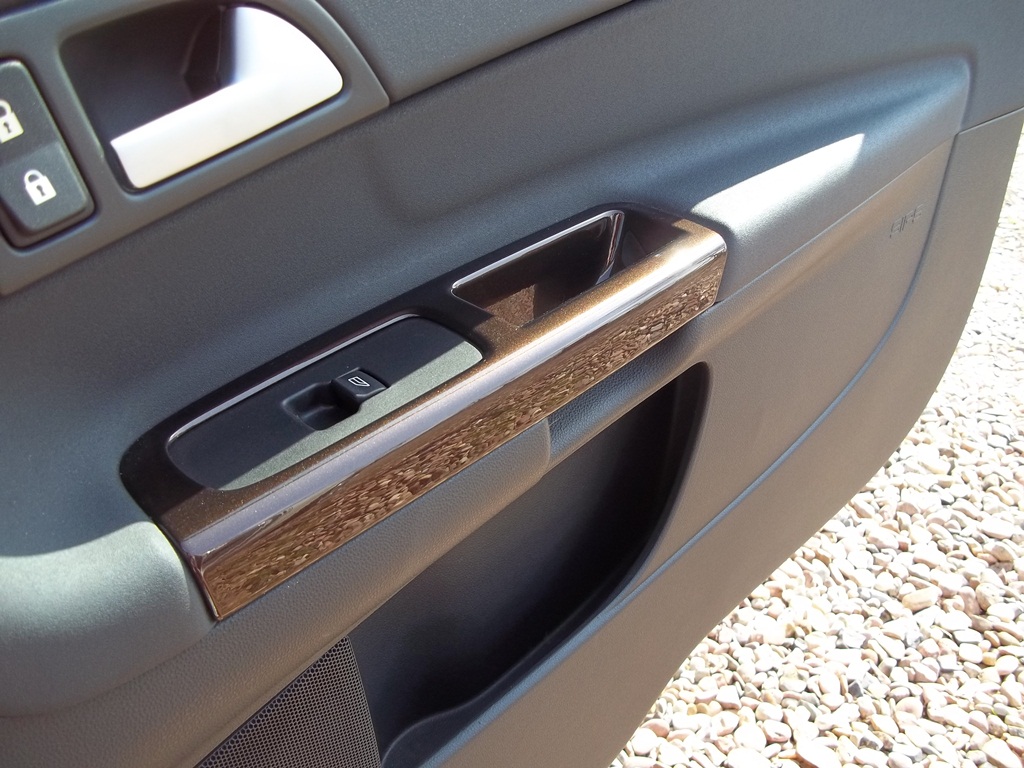
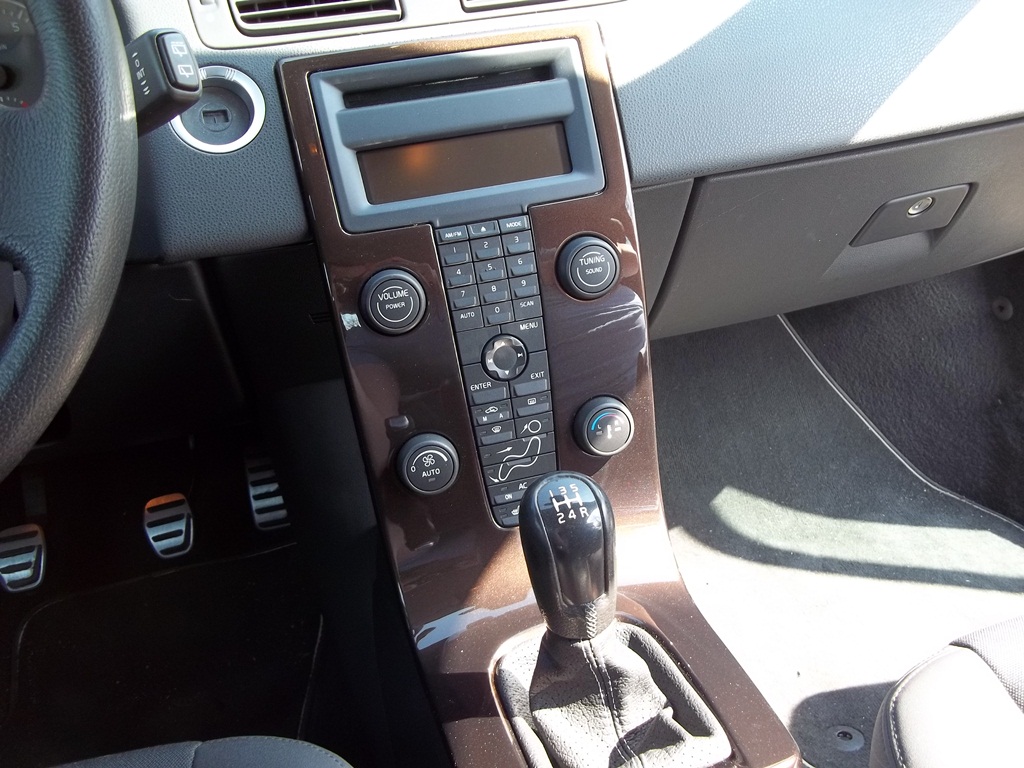
And a close up:
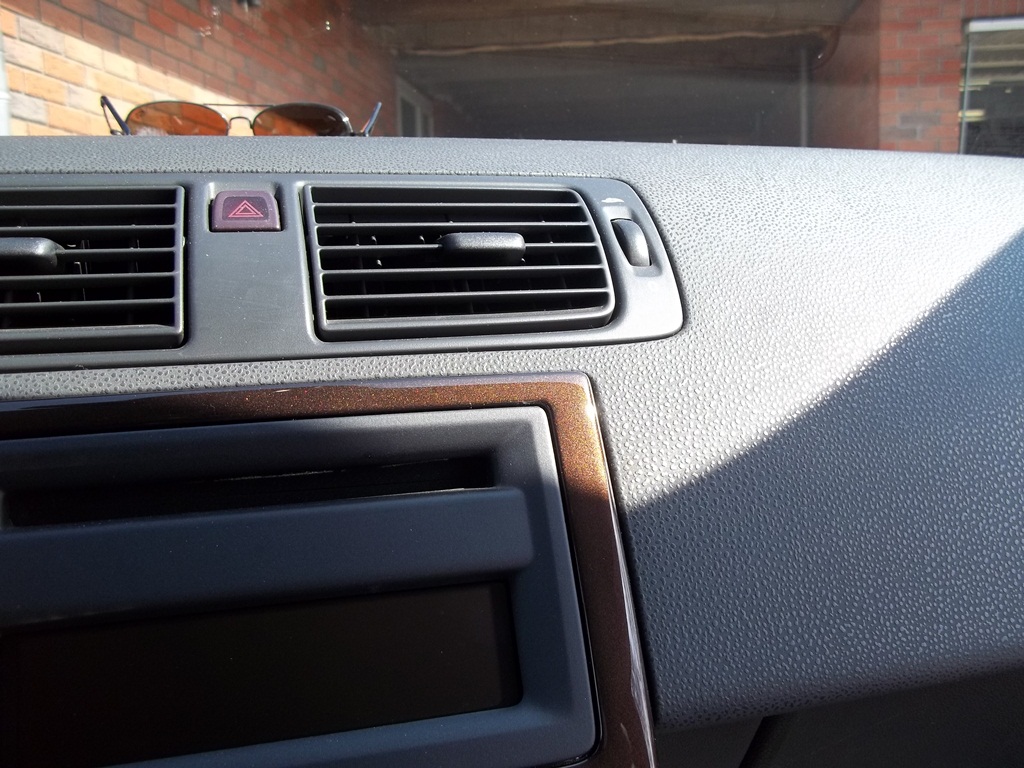
I always had the colour mixed for me and used a 2 component varnish spray can (little cartridge in can) for an optimal finish.
As said, if done right, it can look better than original finish!

I've sprayed enough parts with a rattle can and even metallic paints with a varnish over it. No once has it looked shabby...
For example:


And a close up:

I always had the colour mixed for me and used a 2 component varnish spray can (little cartridge in can) for an optimal finish.

As said, if done right, it can look better than original finish!

The following 2 users liked this post by Daim:
LnrB (08-05-2014),
orangeblossom (08-05-2014)
#83
Iy you can spray well, you won't even notice a difference between a rattle can and spraygun job! 
I've sprayed enough parts with a rattle can and even metallic paints with a varnish over it. No once has it looked shabby...
For example:


And a close up:

I always had the colour mixed for me and used a 2 component varnish spray can (little cartridge in can) for an optimal finish.
As said, if done right, it can look better than original finish!

I've sprayed enough parts with a rattle can and even metallic paints with a varnish over it. No once has it looked shabby...
For example:


And a close up:

I always had the colour mixed for me and used a 2 component varnish spray can (little cartridge in can) for an optimal finish.

As said, if done right, it can look better than original finish!

#84
The following 2 users liked this post by Daim:
Greg in France (08-06-2014),
orangeblossom (08-06-2014)
#85
The following users liked this post:
orangeblossom (08-06-2014)
#86
The following users liked this post:
orangeblossom (08-06-2014)
#87
I've got Two 'almost identical' XJS V12 Radiators that I thought were identical. (but they are not!)
One came out of my 1989 Scrapper and the other one out of 'Cherry Blossom' my 1990 Car that I am restoring.
I took both of them to be tested by a Radiator Company and they have phoned to tell me they both leak and asked me which one of them I would like Re-Cored, which they can do in just a couple of days.
Apparently they are not exactly the same as the fins on one of them are different to the other.
On one Rad the fins are set very close together but on the other Rad they are set further apart.
Good to see that they have their eye on the ball!
They can Re-Core it with either Type, so want to know which one I want but I don't know.
Help needed on this please.
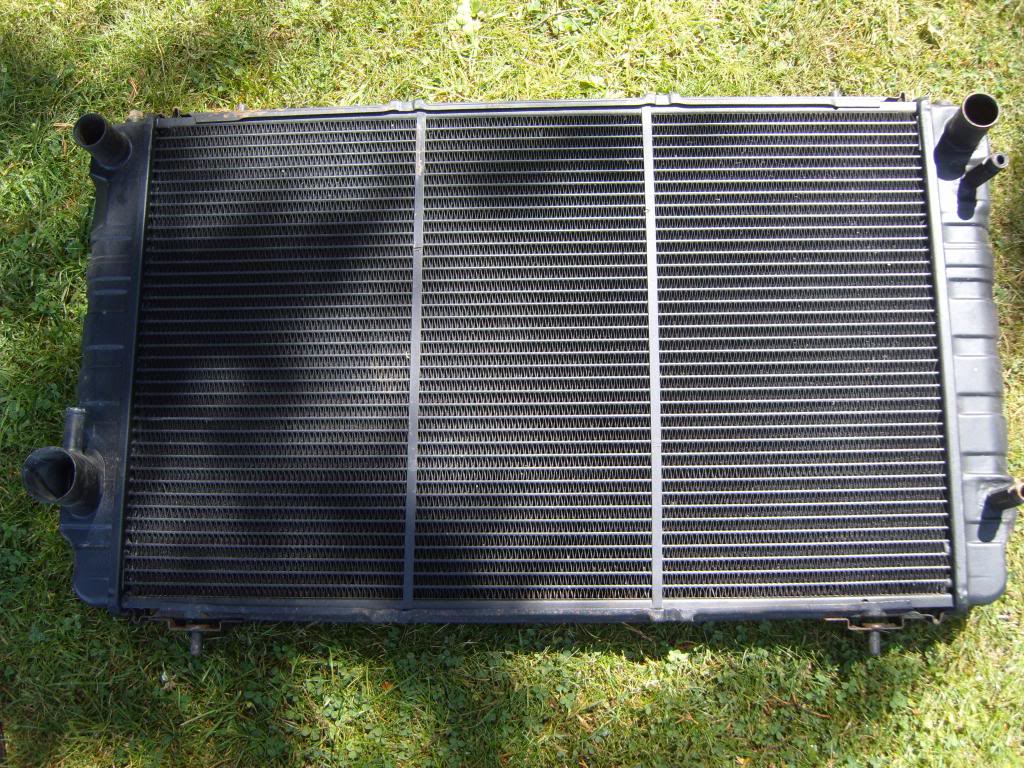
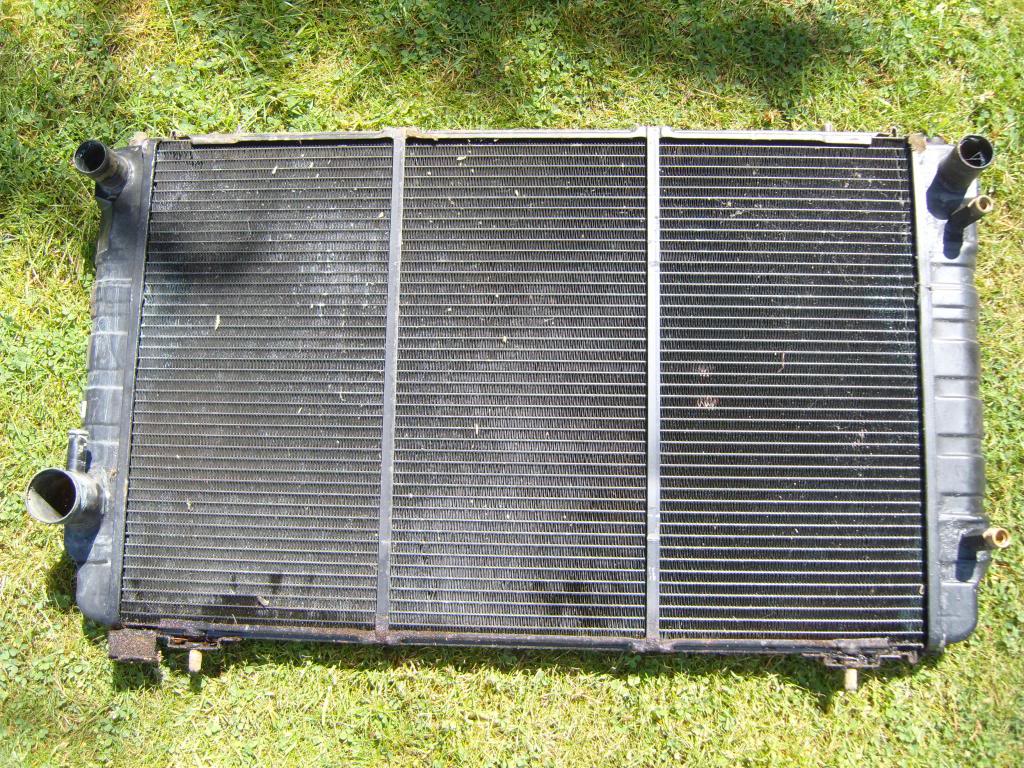
One came out of my 1989 Scrapper and the other one out of 'Cherry Blossom' my 1990 Car that I am restoring.
I took both of them to be tested by a Radiator Company and they have phoned to tell me they both leak and asked me which one of them I would like Re-Cored, which they can do in just a couple of days.
Apparently they are not exactly the same as the fins on one of them are different to the other.
On one Rad the fins are set very close together but on the other Rad they are set further apart.
Good to see that they have their eye on the ball!
They can Re-Core it with either Type, so want to know which one I want but I don't know.
Help needed on this please.


#88
OB
Rad recore a 100% very good idea. The Great Palm says he believes that flow through, as distinct from area of, the radiator, is the key to best cooling. My own ideas re: bumper slot empirically confirm this view, I believe.
Therefore, I say, go for the bigger further apart type of rad core. Getting air to go through it is the problem. According to some people, that is why ally rads cool better, because ally cores have to be made with bigger spaces as they cannot me made with smaller ones. Ally itself is not as good a heat conductor as normal rads are.
Just make sure that the one you are going to use fits easily into CB's slot. The pegs on the rad bottoms are NOT all in the same place! Even worth making a wooden template the size of the width of the bottom of the rad (a piece of wood with a right angle piece screwed on each end, and holes in it in the correct place for the pegs) into which the recored rad must be able to fit. The rad bottom pegs only have to be about 1/2 an inch out in order to make the rad impossible to refit, and/or impossible to get past the oil cooler pipes! Do not ask how I know this !
greg
Rad recore a 100% very good idea. The Great Palm says he believes that flow through, as distinct from area of, the radiator, is the key to best cooling. My own ideas re: bumper slot empirically confirm this view, I believe.
Therefore, I say, go for the bigger further apart type of rad core. Getting air to go through it is the problem. According to some people, that is why ally rads cool better, because ally cores have to be made with bigger spaces as they cannot me made with smaller ones. Ally itself is not as good a heat conductor as normal rads are.
Just make sure that the one you are going to use fits easily into CB's slot. The pegs on the rad bottoms are NOT all in the same place! Even worth making a wooden template the size of the width of the bottom of the rad (a piece of wood with a right angle piece screwed on each end, and holes in it in the correct place for the pegs) into which the recored rad must be able to fit. The rad bottom pegs only have to be about 1/2 an inch out in order to make the rad impossible to refit, and/or impossible to get past the oil cooler pipes! Do not ask how I know this !
greg
The following 4 users liked this post by Greg in France:
#89
OB
Rad recore a 100% very good idea. The Great Palm says he believes that flow through, as distinct from area of, the radiator, is the key to best cooling. My own ideas re: bumper slot empirically confirm this view, I believe.
Therefore, I say, go for the bigger further apart type of rad core. Getting air to go through it is the problem. According to some people, that is why ally rads cool better, because ally cores have to be made with bigger spaces as they cannot me made with smaller ones. Ally itself is not as good a heat conductor as normal rads are.
Just make sure that the one you are going to use fits easily into CB's slot. The pegs on the rad bottoms are NOT all in the same place! Even worth making a wooden template the size of the width of the bottom of the rad (a piece of wood with a right angle piece screwed on each end, and holes in it in the correct place for the pegs) into which the recored rad must be able to fit. The rad bottom pegs only have to be about 1/2 an inch out in order to make the rad impossible to refit, and/or impossible to get past the oil cooler pipes! Do not ask how I know this !
greg
Rad recore a 100% very good idea. The Great Palm says he believes that flow through, as distinct from area of, the radiator, is the key to best cooling. My own ideas re: bumper slot empirically confirm this view, I believe.
Therefore, I say, go for the bigger further apart type of rad core. Getting air to go through it is the problem. According to some people, that is why ally rads cool better, because ally cores have to be made with bigger spaces as they cannot me made with smaller ones. Ally itself is not as good a heat conductor as normal rads are.
Just make sure that the one you are going to use fits easily into CB's slot. The pegs on the rad bottoms are NOT all in the same place! Even worth making a wooden template the size of the width of the bottom of the rad (a piece of wood with a right angle piece screwed on each end, and holes in it in the correct place for the pegs) into which the recored rad must be able to fit. The rad bottom pegs only have to be about 1/2 an inch out in order to make the rad impossible to refit, and/or impossible to get past the oil cooler pipes! Do not ask how I know this !
greg
I was Hoping & Praying that you would reply and my prayers were answered as you did! (Jaguar Gods & All that!)
As just looking at your Set Up, you know all about Cooling a Jag and then Some!
Also so as not to influence anyone else who may have replied, I purposely omitted to say, which Rad came out of which Car.
The Rad with the close packed cores came out of 'Cherry Blossom' and the one with the wider cores came out of 'The Scrapper'
Which has me thinking the Rad on the 'Scrapper' may have been Re-Cored at some time.
What is interesting here is when you look at both Rads.
On the other side of the Closely Cored Rad, it was caked in dirt and flies, restricting the Air Flow.
But on the one with the Wider Spaced Core you could clearly see through from one side to the other.
So even someone like me can tell that the Wide one has much better Air Flow.
My dilemma was based around, do I want More Water Carrying Fins, or Less Fins and more Air Flow.
Which was the Question that you have now answered.
Since I have been 'rained off' to-day, I am going to pick both Rads up, to check on the Pins, which again was something I never thought of.
So I will make up a 'Template' and Post More Pics, probably Tomorrow, so you can cast your knowledgeable eyes all over it.
Thanks for your help.
The following users liked this post:
Greg in France (08-06-2014)
#90
OB,
Interesting topic (and appreciative to Greg for his input). There must be some optimal position of the number of fins, the space it occupies and the ability of air to flow across the fins. As it is the amount of air flowing across the fins which provides the cooling, it's not just about having unrestricted airflow. After all, when the fins corrode and disappear, as they always do, the air has a less restricted and improved flow but the cooling capability at standstill is massively impaired.
I guess radiator designers have the equation designed for optimal cooling, but I wonder if the equation is impacted by type of use? For example, would a radiator cool better if it isn't being driven forward when it has more compact fins than one which is more open? ie if the total surface area of fin that is exposed to non-moving air becomes the more important factor? Whereas, if the car is being driven at speed, maybe the throughput of air starts to become more critical than the total surface area of fins within the rad?
Here in the UK, people often talk about "tropical" cores being preferred. The one factor of these cores seem to be that they are thicker than normal cores.
Any radiator specialists out there?
Paul
Interesting topic (and appreciative to Greg for his input). There must be some optimal position of the number of fins, the space it occupies and the ability of air to flow across the fins. As it is the amount of air flowing across the fins which provides the cooling, it's not just about having unrestricted airflow. After all, when the fins corrode and disappear, as they always do, the air has a less restricted and improved flow but the cooling capability at standstill is massively impaired.
I guess radiator designers have the equation designed for optimal cooling, but I wonder if the equation is impacted by type of use? For example, would a radiator cool better if it isn't being driven forward when it has more compact fins than one which is more open? ie if the total surface area of fin that is exposed to non-moving air becomes the more important factor? Whereas, if the car is being driven at speed, maybe the throughput of air starts to become more critical than the total surface area of fins within the rad?
Here in the UK, people often talk about "tropical" cores being preferred. The one factor of these cores seem to be that they are thicker than normal cores.
Any radiator specialists out there?
Paul
Last edited by ptjs1; 08-06-2014 at 10:14 AM.
The following 2 users liked this post by ptjs1:
Greg in France (08-06-2014),
orangeblossom (08-06-2014)
#91
Most interesting points, Paul. The standard UK spec XJS rad is a two row rad. Which means, I believe, that there are two 'curtains' of fins one behind the other;
Middle East spec Astons, for example, have three row cores (as I was informed by Northampton Autorads) and they made me a three row rad for my car when I moved here. IMO this did not do much for the cooling because of the through the rad airflow points you discussed. However, unbolt the bumper and bingo!
I have a three row in it still, made by a local genius here when the NAR rad started failing (no grumbles about NAR !). The main difference with the three row was that it was deeper front to back, and consequently the aircon condenser in front of it, if its standard fixings to the radtop cross member were used, fouled the bonnet, or it would not fit under the cross member at all, I forget which. I fabricated some short brackets to tilt it forward a few degrees and bent the condenser bracketry over a bit and it got in OK ! But knowing what i know now, I would opt for a "bumper slot and move the plate across a bit towards the LHS indicator lens" solution anytime above a thicker rad.
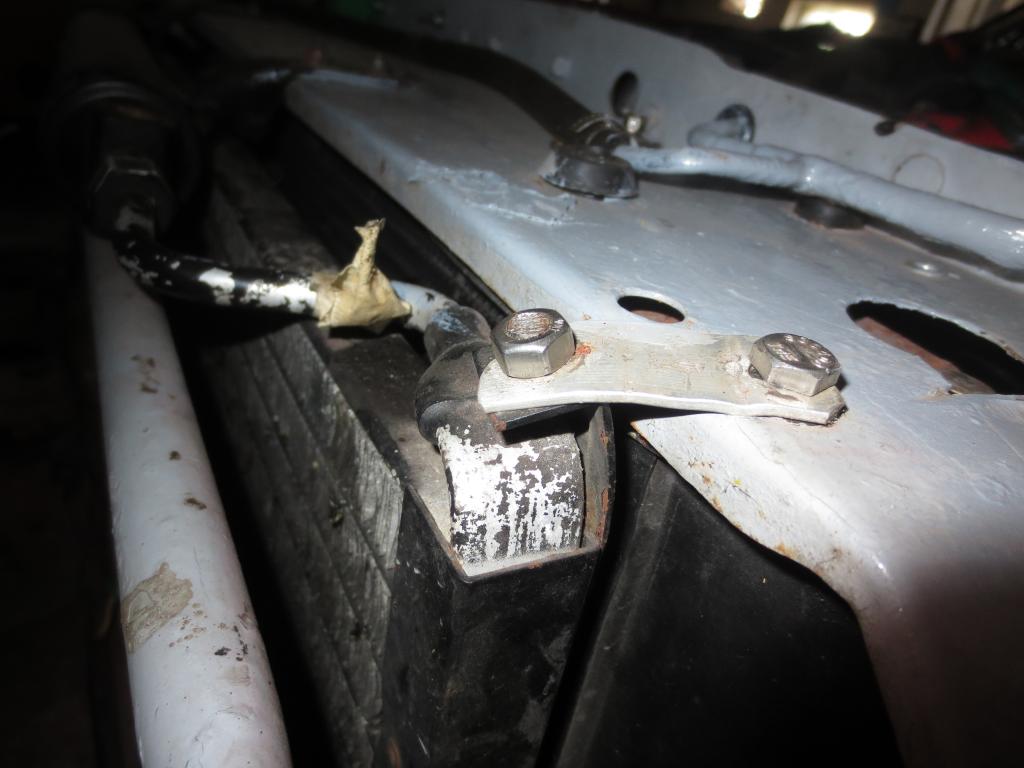
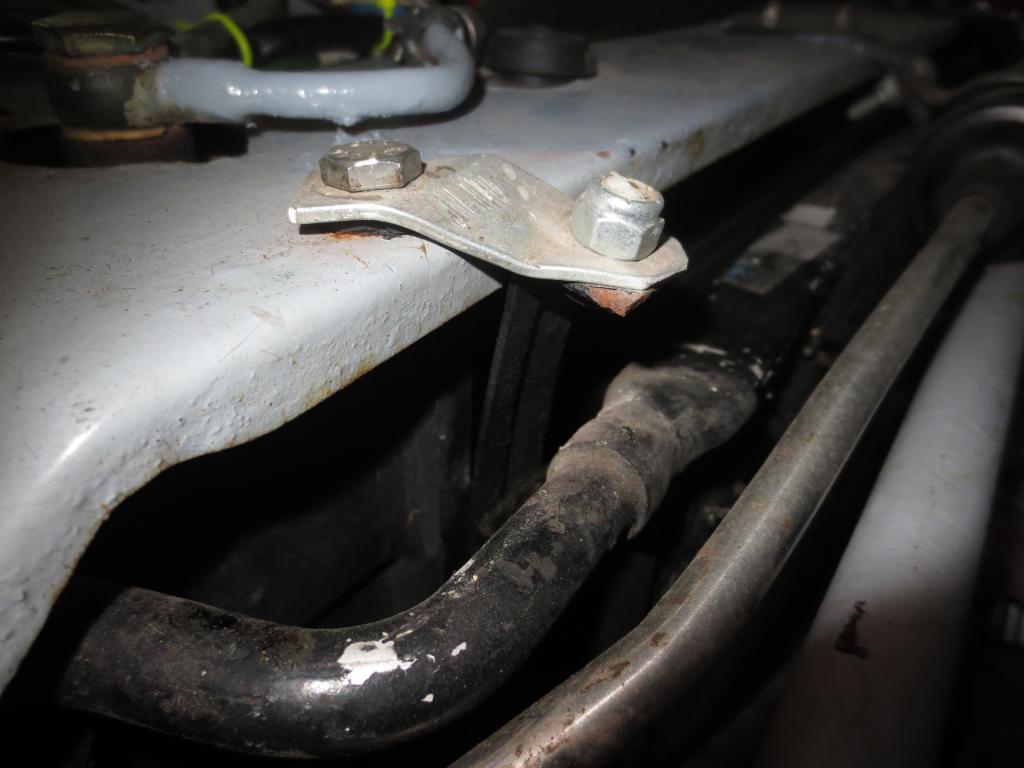
greg
Middle East spec Astons, for example, have three row cores (as I was informed by Northampton Autorads) and they made me a three row rad for my car when I moved here. IMO this did not do much for the cooling because of the through the rad airflow points you discussed. However, unbolt the bumper and bingo!
I have a three row in it still, made by a local genius here when the NAR rad started failing (no grumbles about NAR !). The main difference with the three row was that it was deeper front to back, and consequently the aircon condenser in front of it, if its standard fixings to the radtop cross member were used, fouled the bonnet, or it would not fit under the cross member at all, I forget which. I fabricated some short brackets to tilt it forward a few degrees and bent the condenser bracketry over a bit and it got in OK ! But knowing what i know now, I would opt for a "bumper slot and move the plate across a bit towards the LHS indicator lens" solution anytime above a thicker rad.


greg
Last edited by Greg in France; 08-07-2014 at 01:52 AM.
The following 2 users liked this post by Greg in France:
orangeblossom (08-06-2014),
ptjs1 (08-06-2014)
#92
OB,
Interesting topic (and appreciative to Greg for his input). There must be some optimal position of the number of fins, the space it occupies and the ability of air to flow across the fins. As it is the amount of air flowing across the fins which provides the cooling, it's not just about having unrestricted airflow. After all, when the fins corrode and disappear, as they always do, the air has a less restricted and improved flow but the cooling capability at standstill is massively impaired.
I guess radiator designers have the equation designed for optimal cooling, but I wonder if the equation is impacted by type of use? For example, would a radiator cool better if it isn't being driven forward when it has more compact fins than one which is more open? ie if the total surface area of fin that is exposed to non-moving air becomes the more important factor? Whereas, if the car is being driven at speed, maybe the throughput of air starts to become more critical than the total surface area of fins within the rad?
Interesting topic (and appreciative to Greg for his input). There must be some optimal position of the number of fins, the space it occupies and the ability of air to flow across the fins. As it is the amount of air flowing across the fins which provides the cooling, it's not just about having unrestricted airflow. After all, when the fins corrode and disappear, as they always do, the air has a less restricted and improved flow but the cooling capability at standstill is massively impaired.
I guess radiator designers have the equation designed for optimal cooling, but I wonder if the equation is impacted by type of use? For example, would a radiator cool better if it isn't being driven forward when it has more compact fins than one which is more open? ie if the total surface area of fin that is exposed to non-moving air becomes the more important factor? Whereas, if the car is being driven at speed, maybe the throughput of air starts to become more critical than the total surface area of fins within the rad?
The single most important variable is the temperature differential. On a colder day no XJS ever overheats! The second is the flow of air through rather than up to, the rad, both the airspeed and the 'hole size' affect this. Even more importantly, the in-service ability of the matrix to stay clean is important. As OB's flies on the small matrix show, efficiency drops sharply as soon as blockages occur (or on a V12 XJS as soon as the gap between the rad and the oil cooler gets half blocked with oily crud). Next the cleanliness of the incoming airflow is crucial too; aerodynamically 'dirty' (ie turbulent) air will greatly affect the airflow through the matrix, just like over a wing.
Next, the efficiency of any given installation will depend upon its actual physical mounting, and there can be no generalisation, because the mounting circumstances so greatly affect the cooling ability of the matrix. Taking a given set of circumstances (eg a V12 XJS with the bumper unchanged from standard and - on Lucas cars - the secondary coil in the airflow, and the horns there too) it is quite easy to calculate the heat rejection capability of the rad, but you need empirical measurement to give some data to start with. Remove all the stuff from in front of an XJS rad and I am sure you could reduce the rad area by 20% without any overheating danger at all, whatever the matrix size within reason. Of course car designers have a pretty good ballpark idea of what the engine produces, what cooling ability is needed to cope with it, and what size rad this implies. But as we all know there is no substitute for trying it out.
You may remember the great Gordon Murray, brilliant car designer for the McLaren F1 road car, previously designed the world championship Brabham 1980s F1 race cars when Bernie owned the team? He tried out a surface-rad cooled F1 car in the early 1980s, the idea being no rad in the airflow and thus much, much less drag. The heat was meant to pass out of a thin sandwich of coolant spread like a skin all over the car's bodywork. One must assume all calcs showed it would work. In the event, disastrous immediate overheating in mid winter tests was the outcome! So everyone needs real tests on the actual installation!
The actual capacity of the system is another variable. Imagine a river running through your XJS and it would not need a rad at all! The larger the volume of water in your system for a given block coolant capacity, the more time in principle it can spend in the rad getting cooled. Which undoubtedly is why the V12 has such a huge water capacity. Modern cars, as you know, have far smaller capacities to aid fast warm-up to pass stringent start-up cycle emissions requirements and reduce weight. So in my Mondeo 2 litre petrol engine the coolant capacity is (pro rata) about half that of my XJS. Better pumps, thinner block water passage castings, better rad matrices, tighter margins, all account for it.
I have never seen one, but I have been told (correctly or not I do not know) that the Spitfire's Merlin engine's radiator installation is smaller in area, though deeper, than that in a V12 Jaguar. But of course, it has much faster airflow at very low temperatures and runs 100% glycol, I think. So flow and incoming air temp are key and matrix size is not that important, within limits obviously. While the ability to staying performing near to spec in service (the V12 XJS's Achilles heel all round!) is paramount for the owner.
Greg
Last edited by Greg in France; 08-06-2014 at 01:22 PM.
The following 3 users liked this post by Greg in France:
#93
Paul
The single most important variable is the temperature differential. On a colder day no XJS ever overheats! The second is the flow of air through rather than up to, the rad, both the airspeed and the 'hole size' affect this. Even more importantly, the in-service ability of the matrix to stay clean is important. As OB's flies on the small matrix show, efficiency drops sharply as soon as blockages occur (or on a V12 XJS as soon as the gap between the rad and the oil cooler gets half blocked with oily crud). Next the cleanliness of the incoming airflow is crucial too; aerodynamically 'dirty' (ie turbulent) air will greatly affect the airflow through the matrix, just like over a wing.
Next, the efficiency of any given installation will depend upon its actual physical mounting, and there can be no generalisation, because the mounting circumstances so greatly affect the cooling ability of the matrix. Taking a given set of circumstances (eg a V12 XJS with the bumper unchanged from standard and - on Lucas cars - the secondary coil in the airflow, and the horns there too, it is quite easy to calculate the heat rejection capability of the rad, but you need empirical measurement to give some data to start with. Remove all the stuff from in front of an XJS rad and I am sure you could reduce the rad area by 20% without any overheating danger at all, whatever the matrix size within reason. Of course car designers have a pretty good ballpark idea of what the engine produces, what cooling ability is needed to cope with it, and what size rad this implies. But as we all know there is no substitute for trying it out.
You may remember the great Gordon Murray, brilliant car designer for the McLaren F1 road car, previously designed the world championship Brabham 1980s F1 race cars when Bernie owned the team? He tried out a surface-rad cooled F1 car in the early 1980s, the idea being no rad in the airflow and thus much, much less drag. The heat was meant to pass out of a thin sandwich of coolant spread like a skin all over the car's bodywork. One must assume all calcs showed it would work. In the event, disastrous immediate overheating in mid winter tests was the outcome! So everyone needs real tests on the actual installation!
The actual capacity of the system is another variable. Imagine a river running through your XJS and it would not need a rad at all! The larger the volume of water in your system for a given block coolant capacity, the more time in principle it can spend in the rad getting cooled. Which undoubtedly is why the V12 has such a huge water capacity. Modern cars, as you know, have far smaller capacities to aid fast warm-up to pass stringent start-up cycle emissions requirements and reduce weight. So in my Mondeo 2 litre petrol engine the coolant capacity is (pro rata) about half that of my XJS. Better pumps, thinner block water passage castings, better rad matrices, tighter margins, all account for it.
I have never seen one, but I have been told (correctly or not I do not know) that the Spitfire's Merlin engine's radiator installation is smaller in area, though deeper, than that in a V12 Jaguar. But of course, it has much faster airflow at very low temperatures and runs 100% glycol, I think. So flow and incoming air temp are key and matrix size is not that important, within limits obviously. While the ability to staying performing near to spec in service (the V12 XJS's Achilles heel all round!) is paramount for the owner.
Greg
The single most important variable is the temperature differential. On a colder day no XJS ever overheats! The second is the flow of air through rather than up to, the rad, both the airspeed and the 'hole size' affect this. Even more importantly, the in-service ability of the matrix to stay clean is important. As OB's flies on the small matrix show, efficiency drops sharply as soon as blockages occur (or on a V12 XJS as soon as the gap between the rad and the oil cooler gets half blocked with oily crud). Next the cleanliness of the incoming airflow is crucial too; aerodynamically 'dirty' (ie turbulent) air will greatly affect the airflow through the matrix, just like over a wing.
Next, the efficiency of any given installation will depend upon its actual physical mounting, and there can be no generalisation, because the mounting circumstances so greatly affect the cooling ability of the matrix. Taking a given set of circumstances (eg a V12 XJS with the bumper unchanged from standard and - on Lucas cars - the secondary coil in the airflow, and the horns there too, it is quite easy to calculate the heat rejection capability of the rad, but you need empirical measurement to give some data to start with. Remove all the stuff from in front of an XJS rad and I am sure you could reduce the rad area by 20% without any overheating danger at all, whatever the matrix size within reason. Of course car designers have a pretty good ballpark idea of what the engine produces, what cooling ability is needed to cope with it, and what size rad this implies. But as we all know there is no substitute for trying it out.
You may remember the great Gordon Murray, brilliant car designer for the McLaren F1 road car, previously designed the world championship Brabham 1980s F1 race cars when Bernie owned the team? He tried out a surface-rad cooled F1 car in the early 1980s, the idea being no rad in the airflow and thus much, much less drag. The heat was meant to pass out of a thin sandwich of coolant spread like a skin all over the car's bodywork. One must assume all calcs showed it would work. In the event, disastrous immediate overheating in mid winter tests was the outcome! So everyone needs real tests on the actual installation!
The actual capacity of the system is another variable. Imagine a river running through your XJS and it would not need a rad at all! The larger the volume of water in your system for a given block coolant capacity, the more time in principle it can spend in the rad getting cooled. Which undoubtedly is why the V12 has such a huge water capacity. Modern cars, as you know, have far smaller capacities to aid fast warm-up to pass stringent start-up cycle emissions requirements and reduce weight. So in my Mondeo 2 litre petrol engine the coolant capacity is (pro rata) about half that of my XJS. Better pumps, thinner block water passage castings, better rad matrices, tighter margins, all account for it.
I have never seen one, but I have been told (correctly or not I do not know) that the Spitfire's Merlin engine's radiator installation is smaller in area, though deeper, than that in a V12 Jaguar. But of course, it has much faster airflow at very low temperatures and runs 100% glycol, I think. So flow and incoming air temp are key and matrix size is not that important, within limits obviously. While the ability to staying performing near to spec in service (the V12 XJS's Achilles heel all round!) is paramount for the owner.
Greg
Although I'm slightly blinded with the 'Science' of all that, I sort of get what you are both talking about.
If you thought that the fins looked blocked on the Rad with the Smaller fins, then just wait till I show you a photo of the other side of it.
Also I will have a look on my Grey Car, as that runs Ice Cold all the time even in a Heatwave, although the electric fan does sometimes cut in.
The temperature has never moved out of the bottom quarter of the gauge.
#94
Two XJS V12 Radiators Compared
I need to have one of them Re-Cored for 'Cherry' my 1990 V12 XJS Convertible.
The one with the wider fins came out of my Scrap 1989 V12 hard top
The one with the smaller fins from my 1990 V12 Convertible
As you should be able to tell from the photos, the fittings and pegs are identical on both Rads.
The only difference from what I can see is the size and spacing of the fins.
I also checked the size of the fins on my other XJS which is up and running and is now in regular use as my Summer Car (Thanks to 'Greg in France') & others who have helped with their advice.
The Rad in this Car also has smaller fins.
Which is making me think that the Rad from the 89 'Scrap Car' is no longer OEM because going on its Condition, it may have been Re-Cored at some stage as it may have been leaking.
Having had both Rads Tested, the result is 'They Both Leak' so one or the other will have to be Re-Cored.
Since the Rad from the 89 looks in better overall Condition, it may make sense to use this one as a donor.
The Rad Company can refurbish it to OEM with the Smaller closely packed Cores or The bigger spaced Cores as on the 89.
All they need to know is, which type I would prefer.
More Airflow or More Waterflow?
Which is a hard decision for me, as I have to confess that I don't have a clue which way to go.
All I do know is my Grey XJS V12 has the OEM smaller cores and runs cold even in a Heatwave, though the electric fan cuts in from time to time.
The Radiator Company that I am using, say its all a case of 'swings & roundabouts'
So did Jaguar get it right with the smaller core or has anyone had better results using the more open type?
Since I don't have that expertise I really do not know which way to jump.
Over to you, I need help.
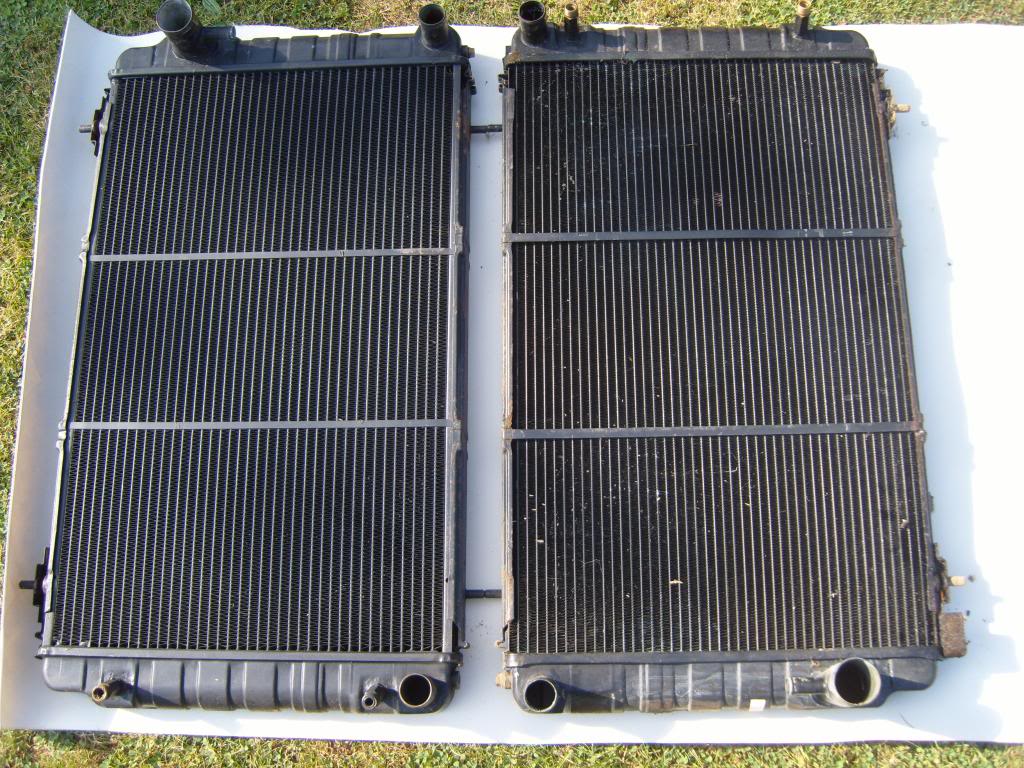
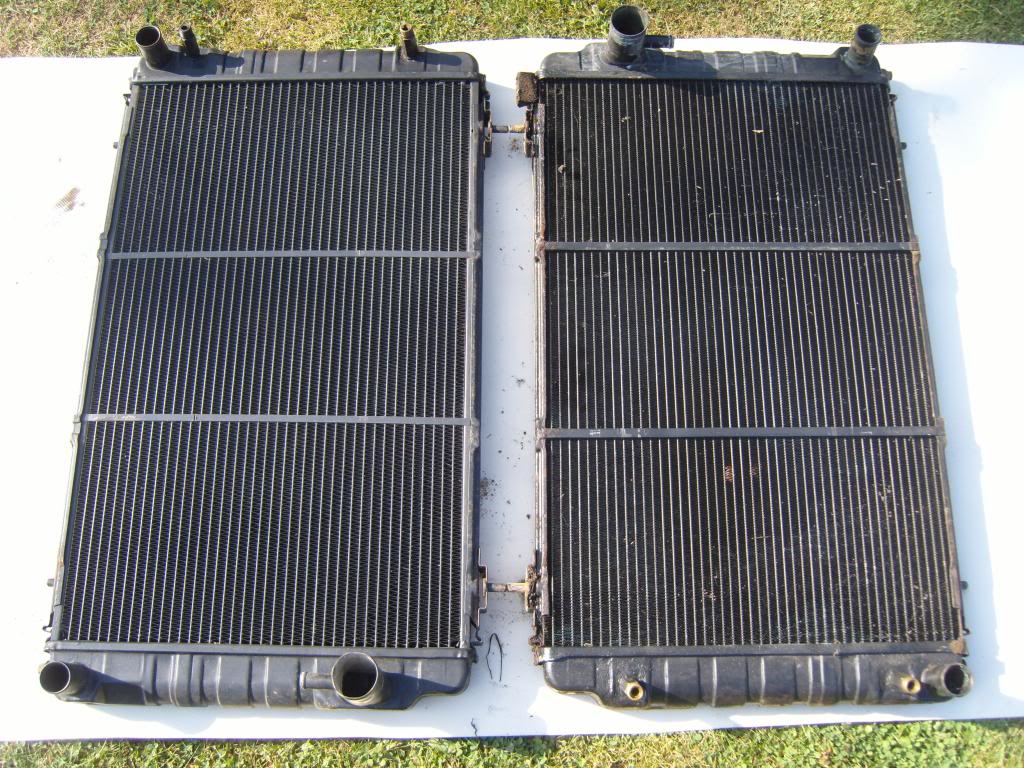
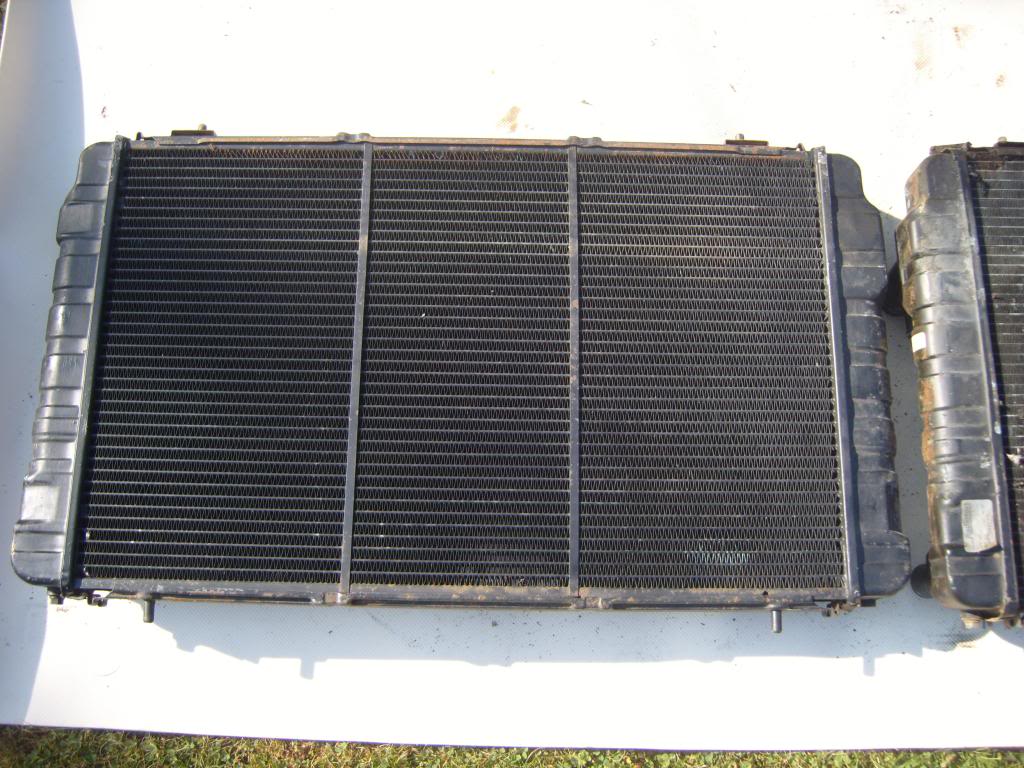
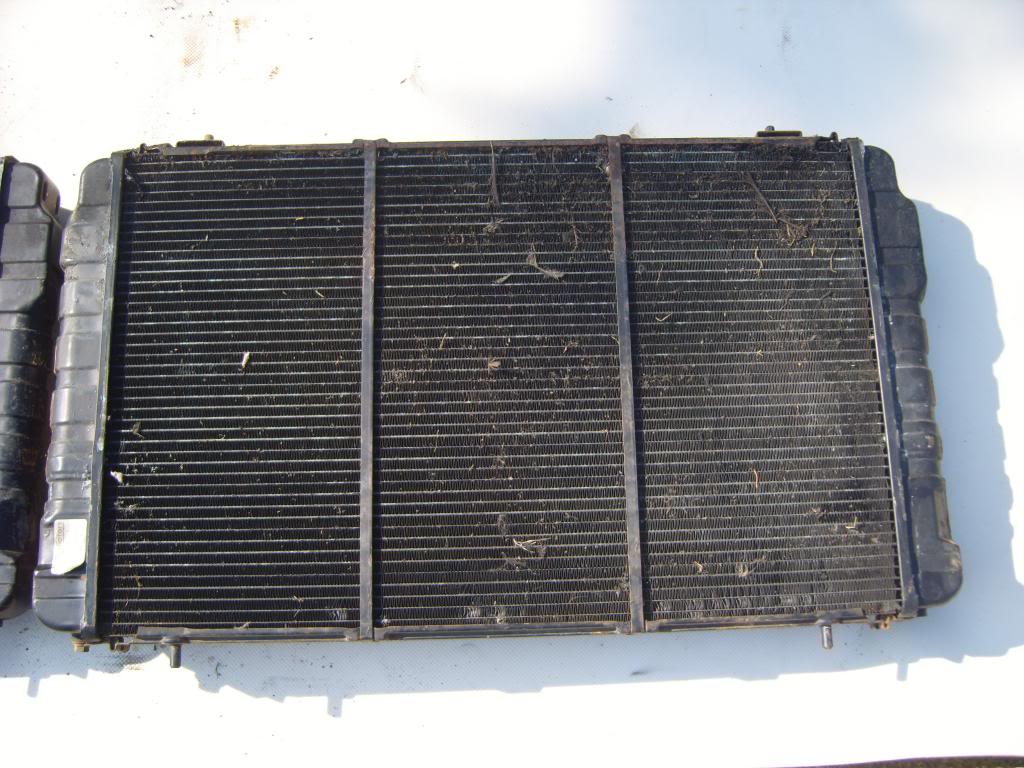
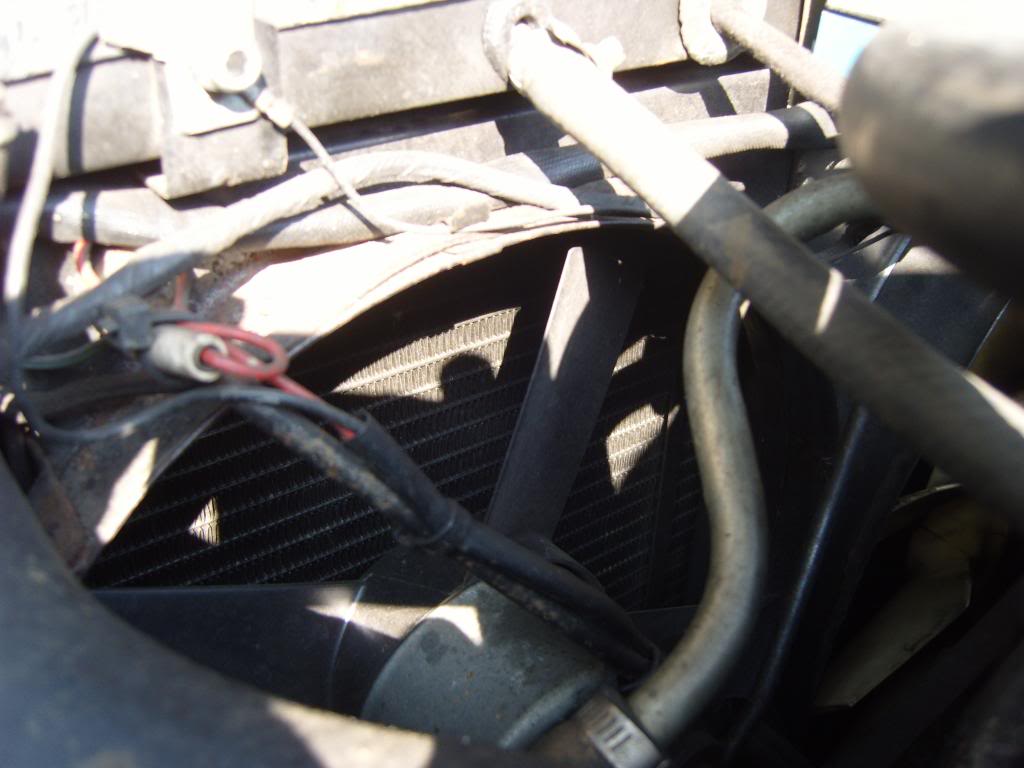
I need to have one of them Re-Cored for 'Cherry' my 1990 V12 XJS Convertible.
The one with the wider fins came out of my Scrap 1989 V12 hard top
The one with the smaller fins from my 1990 V12 Convertible
As you should be able to tell from the photos, the fittings and pegs are identical on both Rads.
The only difference from what I can see is the size and spacing of the fins.
I also checked the size of the fins on my other XJS which is up and running and is now in regular use as my Summer Car (Thanks to 'Greg in France') & others who have helped with their advice.
The Rad in this Car also has smaller fins.
Which is making me think that the Rad from the 89 'Scrap Car' is no longer OEM because going on its Condition, it may have been Re-Cored at some stage as it may have been leaking.
Having had both Rads Tested, the result is 'They Both Leak' so one or the other will have to be Re-Cored.
Since the Rad from the 89 looks in better overall Condition, it may make sense to use this one as a donor.
The Rad Company can refurbish it to OEM with the Smaller closely packed Cores or The bigger spaced Cores as on the 89.
All they need to know is, which type I would prefer.
More Airflow or More Waterflow?
Which is a hard decision for me, as I have to confess that I don't have a clue which way to go.
All I do know is my Grey XJS V12 has the OEM smaller cores and runs cold even in a Heatwave, though the electric fan cuts in from time to time.
The Radiator Company that I am using, say its all a case of 'swings & roundabouts'
So did Jaguar get it right with the smaller core or has anyone had better results using the more open type?
Since I don't have that expertise I really do not know which way to jump.
Over to you, I need help.





Last edited by orangeblossom; 08-07-2014 at 04:50 AM.
The following users liked this post:
paulyling (10-28-2016)
#95
Join Date: Jul 2010
Location: Austin tx and Daytona FL.
Posts: 7,362
Received 1,231 Likes
on
939 Posts
The following users liked this post:
orangeblossom (08-08-2014)
#96
OB,
I think that for UK climate, even with aircon being used a good original setup should work fine on a well-maintained car.
So, I would ask around at the reputable rad reconditioning companies and go with whatever they think. In reconditioning your rad, they will be putting a new core in anyway and reusing your existing input and output tanks, so it doesn't matter which one you use of the 2 rads that you have.
With a recored rad, a good flush through of the engine and heater matrix, good quality coolant, new thermostats, sound hoses, a good waterpump and quality rad caps, the car will run fine.
If your gauge always shows cold but the fan cuts in occasionally, I suspect the sensor or gauge may not be entirely accurate anyway.
Find the right company to do the work and you'll be fine!
Good luck
Paul
I think that for UK climate, even with aircon being used a good original setup should work fine on a well-maintained car.
So, I would ask around at the reputable rad reconditioning companies and go with whatever they think. In reconditioning your rad, they will be putting a new core in anyway and reusing your existing input and output tanks, so it doesn't matter which one you use of the 2 rads that you have.
With a recored rad, a good flush through of the engine and heater matrix, good quality coolant, new thermostats, sound hoses, a good waterpump and quality rad caps, the car will run fine.
If your gauge always shows cold but the fan cuts in occasionally, I suspect the sensor or gauge may not be entirely accurate anyway.
Find the right company to do the work and you'll be fine!
Good luck
Paul
The following users liked this post:
orangeblossom (08-08-2014)
#97
Plus I've got to buy 4 new Tires = £800 New Battery £60 (uk)
The list goes on..................
Good idea though!
Thanks O.B.
#98
OB,
I think that for UK climate, even with aircon being used a good original setup should work fine on a well-maintained car.
So, I would ask around at the reputable rad reconditioning companies and go with whatever they think. In reconditioning your rad, they will be putting a new core in anyway and reusing your existing input and output tanks, so it doesn't matter which one you use of the 2 rads that you have.
With a recored rad, a good flush through of the engine and heater matrix, good quality coolant, new thermostats, sound hoses, a good waterpump and quality rad caps, the car will run fine.
If your gauge always shows cold but the fan cuts in occasionally, I suspect the sensor or gauge may not be entirely accurate anyway.
Find the right company to do the work and you'll be fine!
Good luck
Paul
I think that for UK climate, even with aircon being used a good original setup should work fine on a well-maintained car.
So, I would ask around at the reputable rad reconditioning companies and go with whatever they think. In reconditioning your rad, they will be putting a new core in anyway and reusing your existing input and output tanks, so it doesn't matter which one you use of the 2 rads that you have.
With a recored rad, a good flush through of the engine and heater matrix, good quality coolant, new thermostats, sound hoses, a good waterpump and quality rad caps, the car will run fine.
If your gauge always shows cold but the fan cuts in occasionally, I suspect the sensor or gauge may not be entirely accurate anyway.
Find the right company to do the work and you'll be fine!
Good luck
Paul
There is only one big Rad Company near me and they have been going for years.
They even noticed the different Core sizes which I did not even give a thought to and rang me before they went ahead with the Re-Core, to see what I wanted. So to me that's good Customer Service.
I'm thinking of ditching the Air Con Rad altogether, for as Greg pointed out I will get a much better Air Flow through the Main Rad.
While it may be useful, even essential in a hard top in somewhere like France, I can't see that I'd need it in a Convertible.
I've got it fitted and working in my Grey XJS but its too blinking Cold so I had to turn it off!
#99
Join Date: Jan 2014
Location: Delaneys Creek,Qld. Australia
Posts: 28,379
Received 6,317 Likes
on
4,367 Posts
Iy you can spray well, you won't even notice a difference between a rattle can and spraygun job! 
I've sprayed enough parts with a rattle can and even metallic paints with a varnish over it. No once has it looked shabby...
As said, if done right, it can look better than original finish!

I've sprayed enough parts with a rattle can and even metallic paints with a varnish over it. No once has it looked shabby...
As said, if done right, it can look better than original finish!

I do worse jobs with a spray gun. This resto was done completely in my garage except for sand blasting and seat upholstery. You can get some very good results from spray cans..... don't know how this will go on a car,but I have done plenty of motorcycles this way.
Sorry OB
This post is significant because selling this project recovered the funds by double what I purchased the XJ6 for.
Last edited by o1xjr; 08-09-2014 at 07:41 AM.
The following users liked this post:
orangeblossom (08-09-2014)
#100
It is amazing what you can achieve with a spray can if you put you left index finger in your ear and stand on your right foot only with you tongue in the correct position of course,then spray with one eye shut.
I do worse jobs with a spray gun. This resto was done completely in my garage except for sand blasting and seat upholstery. You can get some very good results from spray cans..... don't know how this will go on a car,but I have done plenty of motorcycles this way.
Sorry OB
This post is significant because selling this project recovered the funds by double what I purchased the XJ6 for.
I do worse jobs with a spray gun. This resto was done completely in my garage except for sand blasting and seat upholstery. You can get some very good results from spray cans..... don't know how this will go on a car,but I have done plenty of motorcycles this way.
Sorry OB
This post is significant because selling this project recovered the funds by double what I purchased the XJ6 for.
Jump right in, all this stuff is very interesting.


